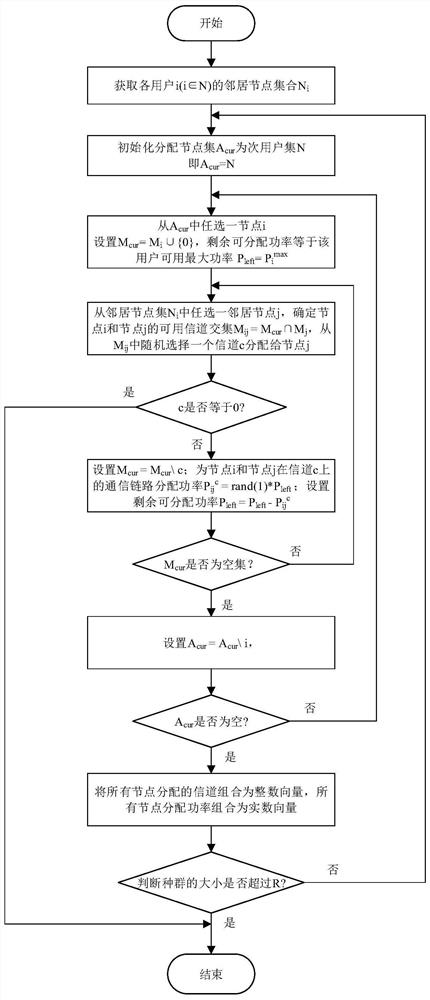A cross-layer optimization device and method based on spectrum aggregation in wireless network
A spectrum aggregation and wireless network technology, which is applied in the field of cross-layer optimization devices, can solve problems such as the organic integration of spectrum aggregation technology and wireless multi-hop communication, and achieve the effect of improving effective capacity, large transmission rate, and improving efficiency
- Summary
- Abstract
- Description
- Claims
- Application Information
AI Technical Summary
Problems solved by technology
Method used
Image
Examples
Embodiment 1
[0044] Example 1, such as figure 2 shown
[0045] A method for applying a cross-layer optimization device based on spectrum aggregation in a wireless network includes the following steps:
[0046] Step1: Each user node executes the spectrum sensing algorithm to obtain a set of available spectrum fragments, where the available spectrum set of any user i (i∈N) is M i ;
[0047] Step2: Collect the maximum available power of each user, where the maximum available power of any user i(i∈N) is P i max ;
[0048] Step3: Based on the perceived spectrum fragment set and the maximum available power of each user, perform an integer-real-number joint coding method to generate T individuals.
[0049] Step4: Calculate the fitness value of each individual in the initialization population sequentially according to the individual fitness value evaluation method;
[0050] Step5: Use the genetic algorithm to perform genetic evolution operations on the generated population in order to impro...
Embodiment 2
[0052] Example 2, such as image 3 shown
[0053] In the above method, the population initialization method based on the joint coding of integer and real numbers in Step3 can adopt the following steps:
[0054] Step3-1: For any user i(i∈N), get the users neighbor node set N i , and set r=1;
[0055] Step3-2: Initialize the distribution node set A cur =N;
[0056] Step3-3: From A cur Choose a node i(i∈N) among them, and allocate communication channels to its neighbor nodes in turn, and the allocation method is:
[0057] (1) M cur = M i ∪{0},P left =P i max;
[0058] (2) From N i Randomly select a neighbor node j; determine the available channel intersection M of node i and node j ij = M cur ∩ M j ; from set M ij ∪{0} randomly selects a channel c and assigns it to node j;
[0059] (3) If c is not equal to 0, then M cur = M cur \c, indicates the power allocation of the communication link between node i and node j on channel c
[0060] (4) If M cur If it is n...
Embodiment 3
[0064] Example 3, such as Figure 4 shown
[0065] The individual fitness value evaluation method in the above method, this method is mainly based on the given resource allocation results, completes the solution of the routing optimization of each individual in the population, and uses the solved objective function as the fitness value of each individual; the specific steps are as follows:
[0066] Step4-1: Topology construction; mainly based on the resource allocation between nodes and neighbor nodes, complete the construction of the directed graph, where if the channel allocated between node i and its neighbor node j is not 0, and the allocated power is not 0 , there is a directed link from node i to node j;
[0067] Step4-2: Calculate the capacity of each directed link in the topology graph according to the spectrum aggregation relationship, select e ij ∈E, extract link e from individual encoding ij The assigned channel set;
[0068] Step4-3: Calculate the SINR value of...
PUM
 Login to View More
Login to View More Abstract
Description
Claims
Application Information
 Login to View More
Login to View More - R&D
- Intellectual Property
- Life Sciences
- Materials
- Tech Scout
- Unparalleled Data Quality
- Higher Quality Content
- 60% Fewer Hallucinations
Browse by: Latest US Patents, China's latest patents, Technical Efficacy Thesaurus, Application Domain, Technology Topic, Popular Technical Reports.
© 2025 PatSnap. All rights reserved.Legal|Privacy policy|Modern Slavery Act Transparency Statement|Sitemap|About US| Contact US: help@patsnap.com



